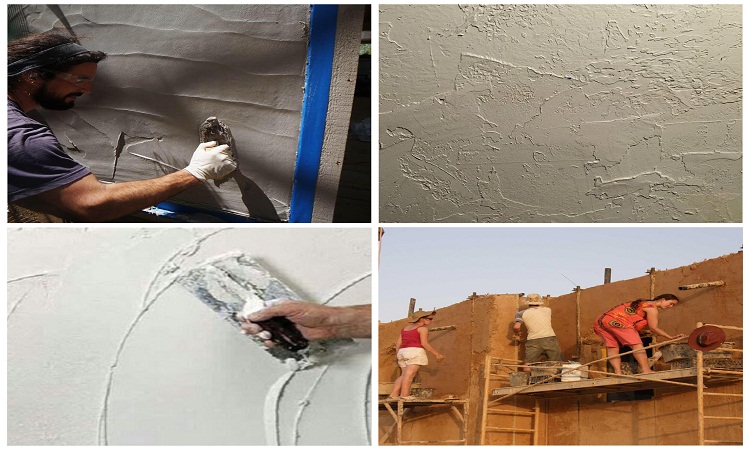Plaster is a building material used for covering the rough surfaces of walls, columns, ceilings, and other building components with a thin coat of plastic mortars to form a smooth durable surface. The coating of plastic material is called plaster. This process is known as plastering.
Plaster is sometimes called render when using the exterior or outer side of the building.
Mortar is a lean mix of binding materials with fillers such as sand or crushed stones.
Objectives of Plastering
- Plaster provides a smooth, regular, smooth, durable, and clean finished surface with improved appearance.
- People use plaster to cover the brick or bare stone on the walls of houses, both outside and inside.
- Plaster can cover unsound and porous material.
- Plaster protects the surface from atmospheric influences.
- Plaster increases the strength of the wall.
- Plasters have the ability to increases the durability or life of the wall.
- Plaster can prevent the penetration of water from one side to another.
- It gives decorative.
- The plaster provides a suitable plain surface for color wash/paints.
- Plaster provides fire prevention up to a certain extent.
Classification of Plaster
Based on Ingredients
- Lime Plaster
- Cement Plaster
- Gypsum Plaster
- Clay Plaster
- Mud Plaster
- Stucco Plaster
- Cow Dung Plaster
Based on Finishes
- Smooth Cast Plaster Finish
- Rough Cast Plaster Finish
- Sand Faced Plaster Finish
- Scrapped Plaster Finish
- Texture Plaster Finish
- Pebble Dash Plaster Finish
Based on Coat
- Single Coat Plaster
- Double Coat Plaster
- Three Coat Plaster
Based on Popularity
- Neeroo Finish Plaster
- Sand Faced Plaster
Based on Proportion
- 1:1
- 1:2
- 1:3
- 1:4
- 1:5
- 1:6
Types of Plaster
Classification Based on Ingredients Used
Lime Plaster
Cement Plaster is also the type of plaster which is a mixture of sand, Portland cement, and water. It is particularly suitable for moist conditions. Cement plaster is generally applied in one coat, which is usually applied to achieve smooth surfaces on the internal and external surface of masonry. Many cement-based plasters are also used as proprietary spray fireproofing products.
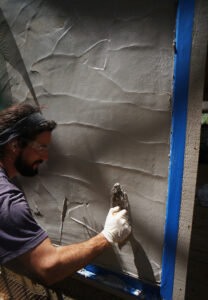
Cement Plaster
Cement plaster is also the type of plaster which is a mixture of Portland cement, sand, and water. It is particularly suitable for moist conditions. Cement plaster is normally applied in one coat, which is usually applied to achieve a smooth surface on the internal and external surface of masonry.
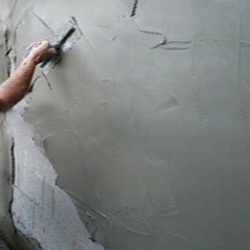
Gypsum Plaster
Gypsum is used as a binding material instead of Portland cement in gypsum plaster. It is available in ready to use format & doesn’t need sand. It is used only on ceilings and internal walls. Again it can’t be used in wet areas like a toilet, bath, kitchen, wash area, etc. gypsum plaster doesn’t require curing which saves up on all that water. Gypsum plaster can be applied to both rough and smooth surfaces.
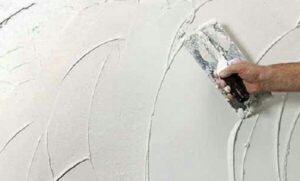
Clay Plaster
Clay plaster is a mixture of clay & sand that makes a beautiful, durable surface. Clay plaster is made up of cheap and non-toxic ingredients. Clay has the natural ability to control moisture & heat from the surrounding air. Materials can often be found on the local building sites.
The techniques for mixing and applying clay plaster are very simple and clay plaster is very indulgent, even for beginners. Clay plasters are only suitable for interior surfaces.
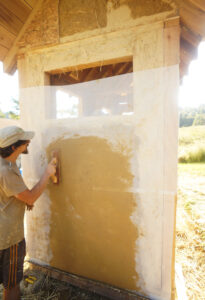
Mud Plaster/Cow Dung Plaster
Mud plaster or Cow dung plaster is prepared from equal volumes of clay or well-tempered brick earth and chopped straw, cow dung, or loose soil. All these elements are thoroughly mixed and left for about 7 days with a large quantity of water. This is mixed again thoroughly till it comes to the desired mortar consistency.
Mud plaster is bar oldest and very cheap. Generally, mud plaster is done in construction on a large scale in rural areas for low-cost housing. This type of mud plaster is still done on large scale. Mud walls usually do not have any foundation.
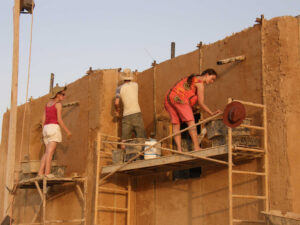
Stucco Plaster
Stucco is a material that consists of aggregates, binders, and water. Stucco is applied wet & it hardens to a very dense solid. It is used as a decorative coating for walls and ceilings and is used as an artistic material in architecture. Stucco plaster may be used to cover less visually attractive construction materials, such as concrete, metal, clay brick, or cinder block and adobe brick. In stucco colored aggregate is used which gives it a beautiful look. The binders are generally chemical and the thickness of the layer is very less.
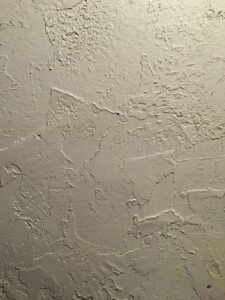
Classification Based on Types of Finishes
Smooth Cast Plaster Finish
In this finish, a smooth, leveled surface is obtained. The mortar for the smooth plaster finish may be made of cement and fine sand. Mortar is applied with the help of a wooden float. Steel floats aren’t suggested for external renderings since they give a very smooth finish which is liable to cracking and crazing under exposure to atmospheric conditions. Generally, this type of plaster is used to coat the internal walls.
Rough Cast Plaster Finish
This plaster is a mixture of gravel and sand, which is covered on freshly plastered surfaces. The mortar used to get roughcast finish consists of coarse aggregate along with cement and sand. A large quantity of mortar is taken by trowel & it is dashed into the surface and leveled wooden float.
Sand Faced Plaster
This plaster is a layer of cement-sand mortar applied on brickwork and also performs as a damp-proof coat over the masonry. This kind of plaster is used to give a finishing touch to a surface on walls and ceilings. To some extent, they also serve as sound insulation and thermal insulation material. This plaster is also used as a decorative touch to the buildings and provides a sustainable base or paint colors.
A sponge is used on the second coat when the second coat is wet/moist. It works like a sand grain and makes the surface uniform and equal. Thus in sand faced plaster, artificial micro-cracks are provided to reduce the cracks.
Scrapped Plaster Finish
Scrapped plaster is a finish in the final coat. After being level, it is allowed to stiffen for a few hours. When it has set, it is scraped with a saw blade or steel straight edge to remove some 2mm from the surface to produce a coarse-textured finish. Several types of scrapped finished can be obtained by using different types of tools.
Textured Plaster Finish
The textured finish is acquired from the stucco plastering. Textured plaster finish can be created with different tools on the final coat of plaster. This type of finish possesses all the advantages of a roughcast finish.
Pebble-Dash Plaster Finish
Pebble-dash plaster is similar to roughcast plaster. It is a finish in which small pebbles or crushed stones of suitable size are used after first the coat of plastering. Pebbles aggregates are dashed on to the coated surface and press on them by using wooden float into the plastered surface slowly. After pressing the slurry of cement is cleared to give a look of only stones. Many times groves or patterns are created to give a better look. After hardening, they provide an aesthetic appearance/look to the structure.
Classification Based on Popularity
Neeroo Plaster Finish
Instant Neeroo is easily available in the market. Prepare a paste of the Neeroo by adding water, two hours before its application on a freshly plastered surface. Instant Neeroo is very convenient and easy to use. A small quantity of cement can be added to Neeroo to improve its bonding with plaster.
The quality of Neeroo should be checked before applying it to the plastered surface.
Mortar for Neeroo finish shall consist of 1 part lime putty and 1 part fine sand. The mixture shall be appropriately ground to a fine paste between two stones.
Sand Faced Plaster
Sand faced plaster is a layer of cement-sand mortar applied over brickwork and it also performs as a damp-proof coat over the masonry. Sand faced plaster is used to give a finishing touch to a surface.
A sponge is used on the second coat when the second is wet. It works like a sand grain and makes the surface uniform and equal. In sand faced plaster, artificial micro-cracks are provided to reduce the cracks.
Classification Based on Coat
Single Coat Plaster
The first coat is called “scratch coat” and it applied to a thickness of 10 mm, then it is scratch or screwed with a comb to give it a rough texture. This is also known as single coat plaster. External plaster is never done in a single coat.
Double Coat Plaster
The second rough coat is made of the same mixture, and it is called “brown coat”. Brown coat is direct to the approximate 10 mm thickness on the scratch coat but leaves the undesired. The sand also provides a rough plaster texture. This is also known as double coat plaster.
Three Coat Plaster
The three-coat plaster system starts with two coats or rough coats. The sand used in the rough-coat plaster is common. This is known as a finish coat plaster.
Classification Based on Proportion
1:1 (1 Cement : 1 Sand)
Cement mortar ratio 1:1 indicates that there is one part of cement or lime and one part of sand. This is a very rich mortar mix.
1:2 (1 Cement : 2 Sand)
Cement mortar ratio 1:2 indicates that there is one part of cement or lime and two-part of sand. This is also a very rich mortar mix.
1:3 (1 Cement : 3 Sand)
Cement mortar ratio 1:3 indicates that there is one part of cement or lime and three-part of sand. This is also a very rich mortar mix. This mortar mix isn’t used in general applications. It can be used as a repair mortar.
1:4 (1 Cement : 4 Sand)
Cement mortar ratio 1:4 indicates that there is one part of cement or lime and four-part of sand.
1:5 (1 Cement : 5 Sand)
Cement mortar ratio 1:5 indicates that there is one part of cement or lime and five-part of sand. There are used in both internal and external plaster. The thickness of the internal plaster can be 12mm and external plaster thickness can be 15mm to 18mm.
1:6 (1 Cement : 6 Sand)
Cement mortar ratio 1:6 indicates that there is one part of cement or lime and six-part of sand. This ratio can be maintained for external plaster. The thickness of the external plaster can be 15mm to 20mm.
Read More:-
Important Questions and Answers on Building Repairs Part-1
Different Types of Cracks in Concrete
What is Structural Appraisal? Principles and Guidelines for Structural Appraisal
What is Structural Audit? Methodology, Guideline, Related Issues, and Durability
The Structural Requirements of Reinforcing Steel
TMT Reinforcement Bars and In RCC Construction Basic Guideline
Building Damage Due to Natural Causes & Designing Procedure
Earthquake Resistant Design and Detailing of Structure
Principle and Practices Followed in the Design and Execution of Tall Buildings
Strengthening of Bridge Structures Using Carbon Fiber Reinforced Polymer (CFRP) System
